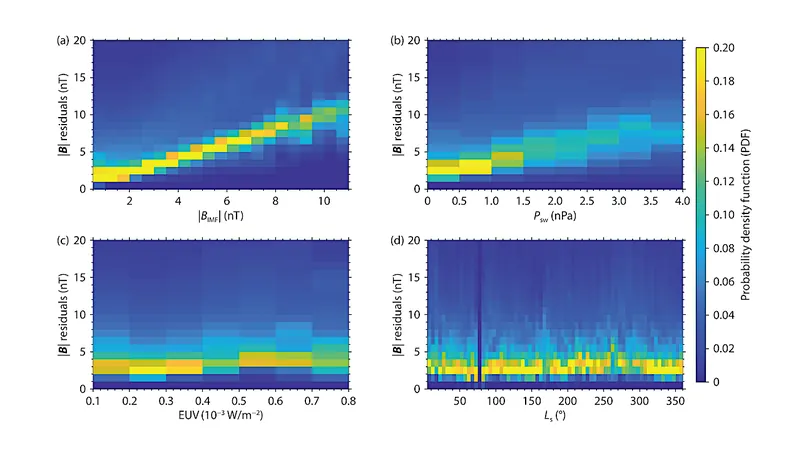
Exploring the Effects of Upstream Solar Wind on Mars' Magnetic Field: A New Insight into the Red Planet's Atmospheric History
2024-09-21
Introduction
A groundbreaking study led by postdoctoral researcher Jiawei Gao from IGGCAS has recently shed light on the complex interplay between solar wind and the magnetic field of Mars, particularly in its nightside ionosphere. Unlike our planet, Mars does not possess a global dipolar magnetic field but does feature locally distributed crustal magnetic fields, which play a significant role in its magnetosphere.
Impact of Solar Wind on Mars' Magnetosphere
Mars is constantly bombarded by solar wind, a stream of charged particles emitted by the Sun, which carries with it the Interplanetary Magnetic Field (IMF). This interaction with Mars’ conductive ionosphere leads to the formation of an induced magnetosphere. The findings of this study, highlighted on the front cover of Earth and Planetary Physics, offer critical insights into how the magnetic field responds to solar conditions, providing a deeper understanding of atmospheric escape processes and the climatic evolution of Mars.
Visual Representations and Findings
Visual representations included in the study compare magnetic field configurations under different solar wind conditions, highlighting how variations in upstream solar wind can significantly alter the induced magnetic field topologies. Researchers noted that the shape and size of the bow shock—this protective layer of magnetic field—is greatly affected by the intensity of the IMF and solar wind dynamic pressure.
Historical Implications for Martian Atmosphere
This research raises important questions regarding the historical impact of solar wind on Martian atmospheric dynamics. As Mars lacks a robust magnetic shield like that of Earth, understanding the influence of historical solar wind conditions is paramount. Data suggests that during the early history of Mars, solar wind events were likely more intense and frequent, potentially leading to higher rates of ionospheric escape compared to the current environment.
Data and Methodology
Utilizing data from NASA's MAVEN (Mars Atmosphere and Volatile EvolutioN) mission from November 2014 to May 2023, the study examined how four main solar wind drivers—IMF intensity, solar wind dynamic pressure, solar extreme ultraviolet (EUV) radiation, and the Martian seasonal variations—influence magnetic field behavior at various altitudes in the ionosphere. Remarkably, the research identified a strong positive correlation between magnetic field residuals and both IMF intensity and solar wind dynamic pressure. Conversely, the relationship with EUV flux and Martian seasons was found to be weak.
Conclusions and Future Implications
Dr. Gao stated, 'Our research not only enhances our understanding of Mars’ contemporary magnetic environment but also opens a window into its atmospheric history. By investigating how Mars’ atmosphere reacted to an active early Sun, we gain insights into its potential to support life, which significantly enriches our ongoing quest to uncover the ancient secrets of Mars.'
This pivotal work not only advances the current scientific knowledge about Mars but also paves the way for future explorations into whether our neighboring planet could have once harbored life, fueled by a more robust and dynamic atmosphere shaped by solar forces.




 Brasil (PT)
Brasil (PT)
 Canada (EN)
Canada (EN)
 Chile (ES)
Chile (ES)
 España (ES)
España (ES)
 France (FR)
France (FR)
 Hong Kong (EN)
Hong Kong (EN)
 Italia (IT)
Italia (IT)
 日本 (JA)
日本 (JA)
 Magyarország (HU)
Magyarország (HU)
 Norge (NO)
Norge (NO)
 Polska (PL)
Polska (PL)
 Schweiz (DE)
Schweiz (DE)
 Singapore (EN)
Singapore (EN)
 Sverige (SV)
Sverige (SV)
 Suomi (FI)
Suomi (FI)
 Türkiye (TR)
Türkiye (TR)